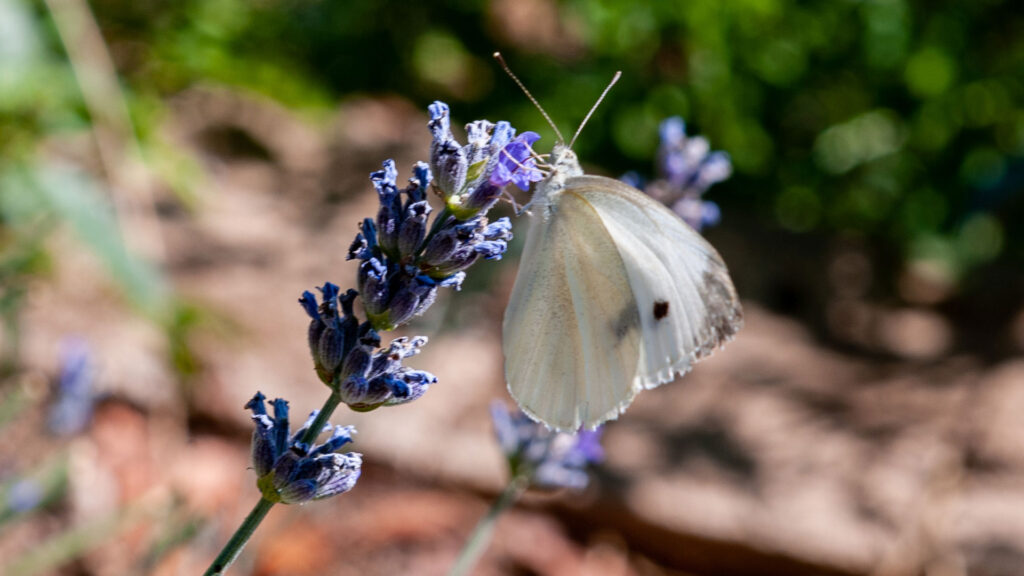
Lavanda selvatica
E’ un piccolo arbusto sempreverde tipico della macchia mediterranea, nasce spontaneamente su zone soleggiate in substrati acidi, la si può trovare sia a livello del mare sia in montagna fino a 1000 metri. Fiorisce tra aprile e maggio in funzione del clima e si possono ammirare le infiorescenze a spiga di colore violaceo attorniate da foglie lineari lanceolate.
E’ molto diffusa in Sardegna, la sua caratteristica principale è la presenza di un ciuffo di petali violacei lungi fino a 5 cm, posti in sommità delle spighe.
Il nome lavanda deriva dal latino “lavare” per ricordare che era molto usata nell’antichità come detergente per il corpo, dai greci e romani come aromatizzante nei loro bagni. Grazie alla presenza di sostanze aromatiche la lavanda viene usata in cucina come condimento, pestata fresca in olio di oliva ha proprietà cicatrizzanti e utile contro il morso degli insetti.
All’olio essenziale estratto dalla lavanda si attribuiscono importanti proprietà anti infiammatorie e persino ipocolesterolemizzanti. Contiene inoltre il “linalolo” una sostanza rilassante che le conferisce proprietà sedative e ansiolitiche. E’ molto usata a livello industriale per profumare saponi e cosmetici, può essere essiccata e usata in sacchetti profuma biancheria e come anti tarme.
E’ una pianta mellifera spesso inserita nei giardini e i mieli prodotti variano a seconda dell’origine.
Wild lavender
It is a small evergreen shrub typical of the Mediterranean scrub, it arises spontaneously on sunny areas in acid substrates, it can be found both at sea level and in the mountains up to 1000 meters. It blooms between April and May depending on the climate and you can admire the purple-colored spiked inflorescences surrounded by linear lanceolate leaves.
It is very common in Sardinia, its main feature is the presence of a tuft of purple petals up to 5 cm long, placed at the top of the ears.
The name lavender derives from the Latin “wash” to remember that it was widely used in ancient times as a cleanser for the body, by the Greeks and Romans as a flavoring in their baths. Thanks to the presence of aromatic substances, lavender is used in the kitchen as a condiment, freshly pounded in olive oil has healing properties and is useful against insect bites. Important anti-inflammatory and even cholesterol-lowering properties are attributed to the essential oil extracted from lavender.
It also contains “linalool” a relaxing substance that gives it sedative and anxiolytic properties. It is widely used industrially to perfume soaps and cosmetics, it can be dried and used in bags, it perfumes linen and as an anti-moth.
It is a melliferous plant often inserted in gardens and the honeys produced vary according to the origin.
Lavande sauvage
C’est un petit arbuste persistant typique du maquis méditerranéen, il se pose spontanément sur des zones ensoleillées dans des substrats acides, on le trouve aussi bien au niveau de la mer qu’en montagne jusqu’à 1000 mètres.
Ses fleurs apparaissent entre avril et mai selon le climat et vous pourrez admirer les inflorescences épineuses de couleur pourpre entourées de feuilles linéaires lancéolées. Elle est très commune sur le territoire de la Sardaigne, sa principale caractéristique est la présence d’une touffe de pétales violets atteignant 5 cm de hauteur placée au sommet des épis.
Le nom lavande dérive du latin “lavage” pour rappeler qu’elle était largement utilisée dans l’Antiquité notamment comme nettoyant pour le corps, par les Grecs et les Romains comme aromatisant dans leurs bains.
Grâce à la présence de substances aromatiques, la lavande est utilisée en cuisine comme condiment, fraîchement pilée dans l’huile d’olive a des propriétés cicatrisantes et est utile contre les piqûres d’insectes. D’importantes propriétés anti-inflammatoires et même hypocholestérolémiantes sont attribuées à l’huile essentielle extraite de la lavande.
Il contient également du « linalol », une substance relaxante qui lui confère des propriétés sédatives et anxiolytiques. Il est également largement utilisé au niveau industriel pour parfumer les savons et les cosmétiques, il peut être séché et utilisé dans les sachets de parfum et comme antimite à mettre dans les tiroirs. C’est une plante mellifère souvent insérée dans les jardins et les miels produits varient selon l’origine.


